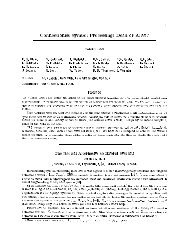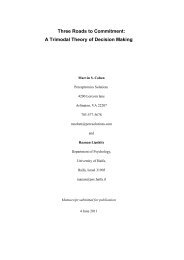Three Roads to Commitment: A Trimodal Theory of Decision Making
Three Roads to Commitment: A Trimodal Theory of Decision Making
Three Roads to Commitment: A Trimodal Theory of Decision Making
You also want an ePaper? Increase the reach of your titles
YUMPU automatically turns print PDFs into web optimized ePapers that Google loves.
<strong>Three</strong> <strong>Roads</strong> <strong>to</strong> <strong>Commitment</strong>: A <strong>Trimodal</strong> <strong>Theory</strong> <strong>of</strong> <strong>Decision</strong> <strong>Making</strong> 56<br />
Brandimonte, M. A. McDaniel & G. O. Einstein (Eds.), Prospective Memory: <strong>Theory</strong> and Applications.<br />
Mahwah NJ: Erlbaum.<br />
Gould, S. J. (1977). Ever Since Darwin: Reflections in Natural His<strong>to</strong>ry. New York: Nor<strong>to</strong>n.<br />
Grice, P. (1989). Studies in the way <strong>of</strong> words. Cambridge MA: Harvard University Press.<br />
Gunther, K. (1993). The Sense <strong>of</strong> Appropriateness: Application Discourses in morality and Law. Albany: State<br />
University <strong>of</strong> New York.<br />
Guth, W., Schmittberger, R., & Schwartze, B. (1982). An experimental analysis <strong>of</strong> ultimatum game bargaining.<br />
Journal <strong>of</strong> economic Behavior and Organization, 3, 367-388.<br />
Hammond, P. J. (1988). Consequentialist Foundations for Expected Utility. <strong>Theory</strong> and <strong>Decision</strong>(25), 25-78.<br />
Hammond, K. R., & Stewart, T. R. (Eds.). (2001). The Essential Brunswick: Beginnings, Explications, Applications.<br />
Oxford, UK: Oxford University Press.<br />
Hanselmann, M., & Tanner, C. (2008). Taboos and conflicts in decision making: Sacred values, decision difficulty,<br />
and emotions. Judgment and <strong>Decision</strong> <strong>Making</strong>, 3(1), 51-63.<br />
Herrnstein, R. J. (1982). Melioration as behavioral dynamism. In M. L. Commons, A. Kacelnik & S. J. Shettleworth<br />
(Eds.), Quantitative Analysis <strong>of</strong> Behavior: Matching and Maximizing Accounts (Vol. II, pp. 433-58).<br />
Cambridge, MA: Ballinger<br />
Herrnstein, R. J. (1997). The Matching Law: Papers in Psychology and Economics. New York: Russell Sage<br />
Foundation.<br />
Herrnstein, R. J., & Prelec, D. (1992). A theory <strong>of</strong> addiction. In G. Loewenstein & J. Elster (Eds.), Choice over Time<br />
(pp. 331-60). New York: Russell Sage Foundation.<br />
H<strong>of</strong>fman, R. R. (Ed.). (2007). Expertise Out <strong>of</strong> Context. Mahwah, NJ: Erlbaum.<br />
Holyoak, K. J., & Thagard, P. (1995). Mental leaps: Analogy in creative thought. Cambridge MA: M.I.T. Press.<br />
Hooker, B., & Streumer, B. (2004). Procedural and substantive practical rationality. In A. R. Mele & P. Rawling<br />
(Eds.), The Oxford Handbook <strong>of</strong> Rationality (pp. 57-74). Oxford: Oxford University.<br />
Hutchins, E. (1995). Cognitive in the wild. Cambridge MA: MIT.<br />
Kahneman, D., Slovic, & Tversky, A. (Ed.). (1982). Judgment under uncertainty: heuristics and biases. New York:<br />
Cambridge University Press.<br />
Kliegel, M., McDaniel, M. A., & Einstein, G. O. (Eds.). (2009). Prospective Memory: An Overview and Synthesis <strong>of</strong><br />
an Emerging Field. New York: Psychology Press.




